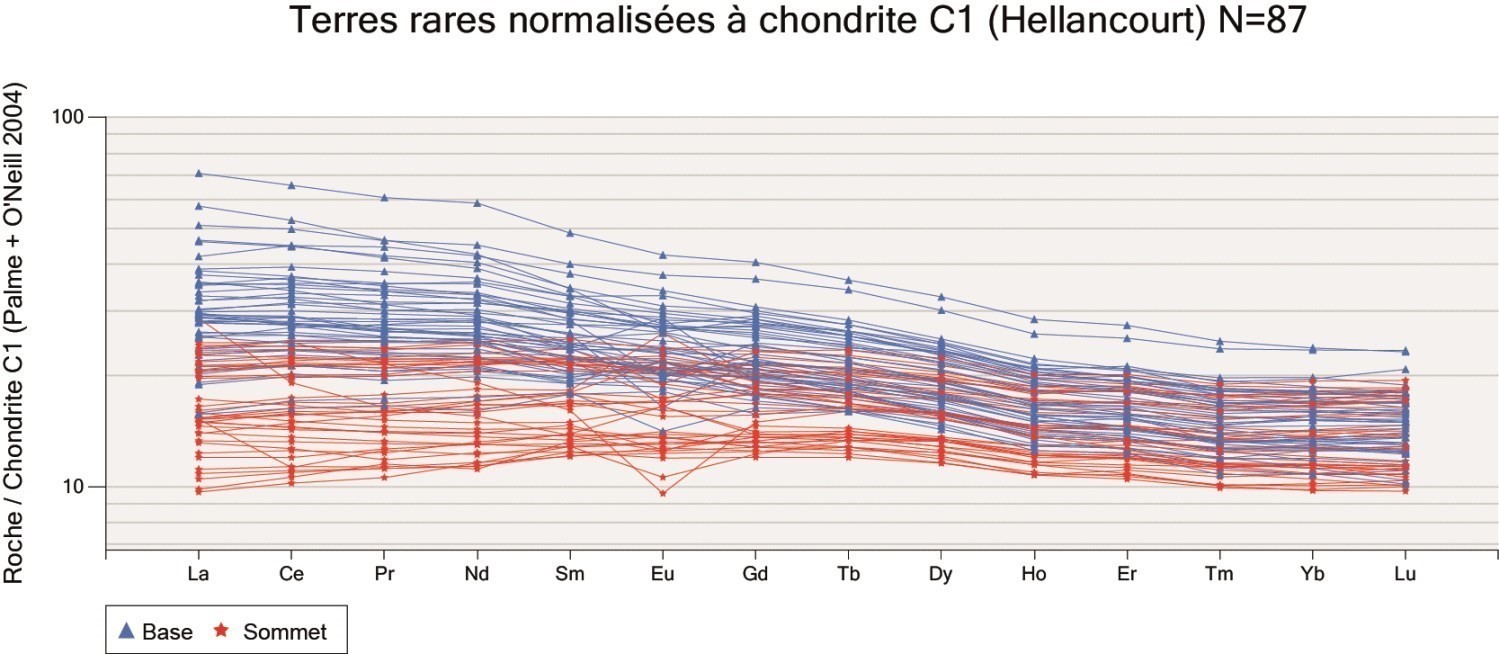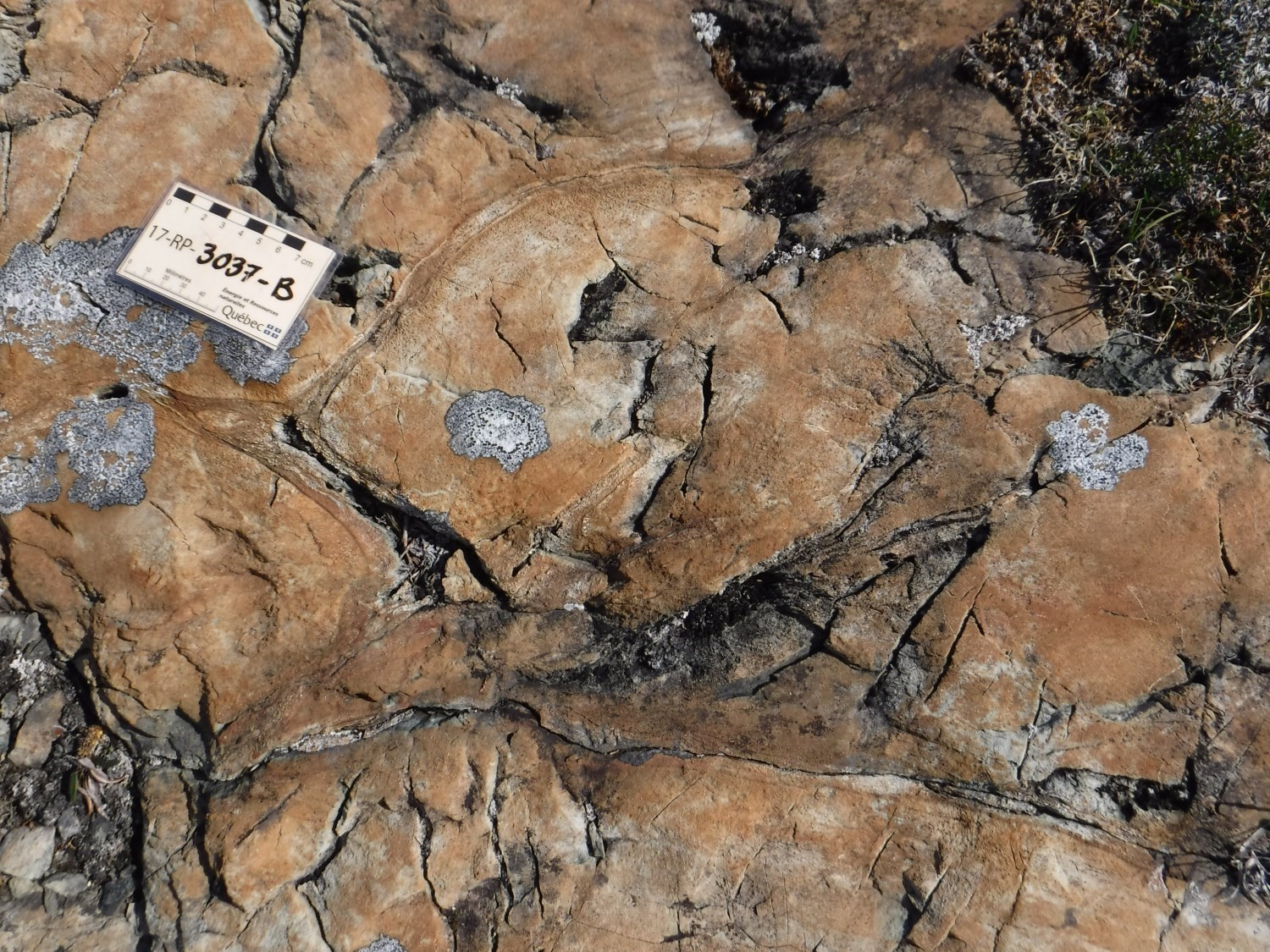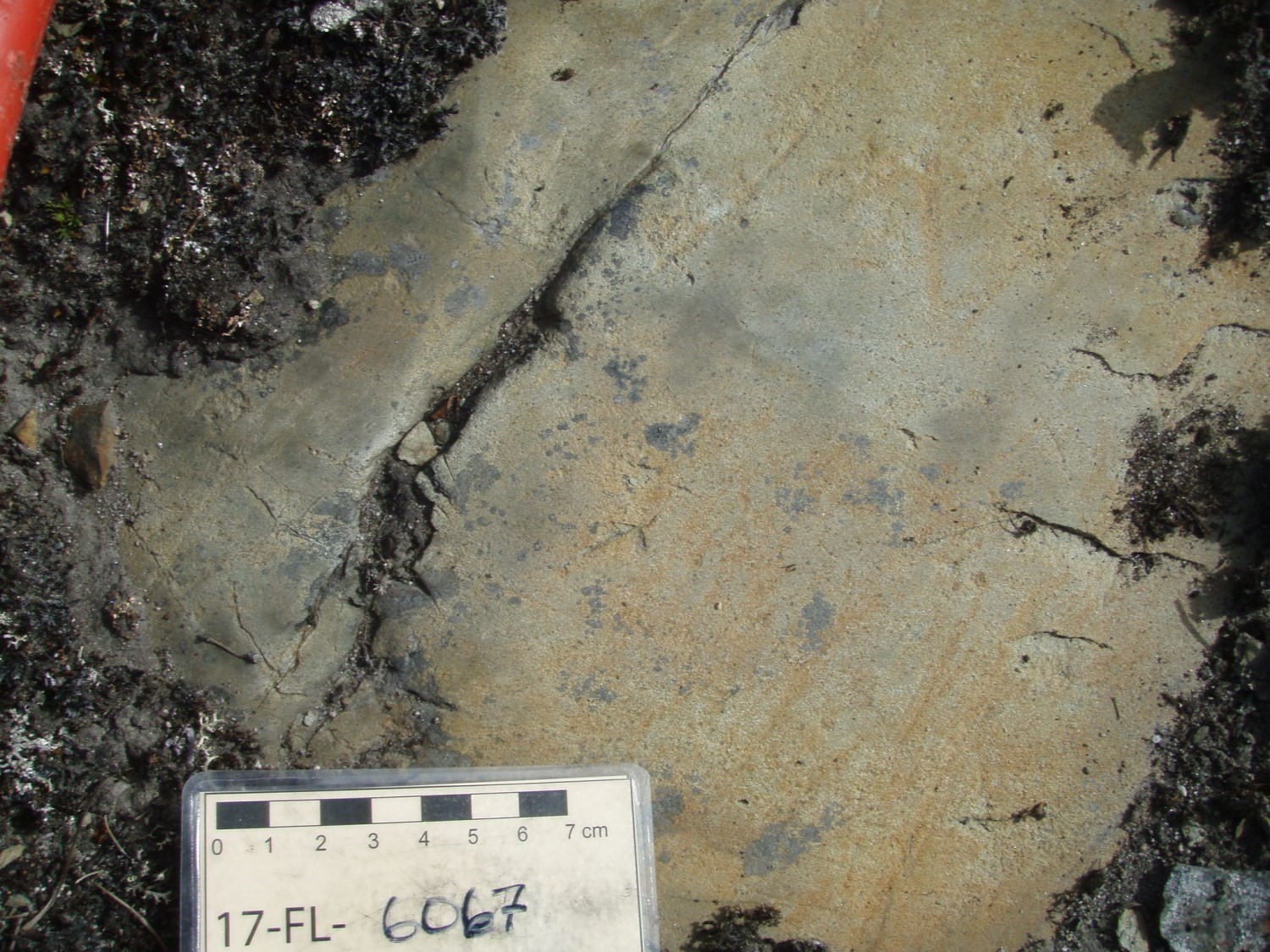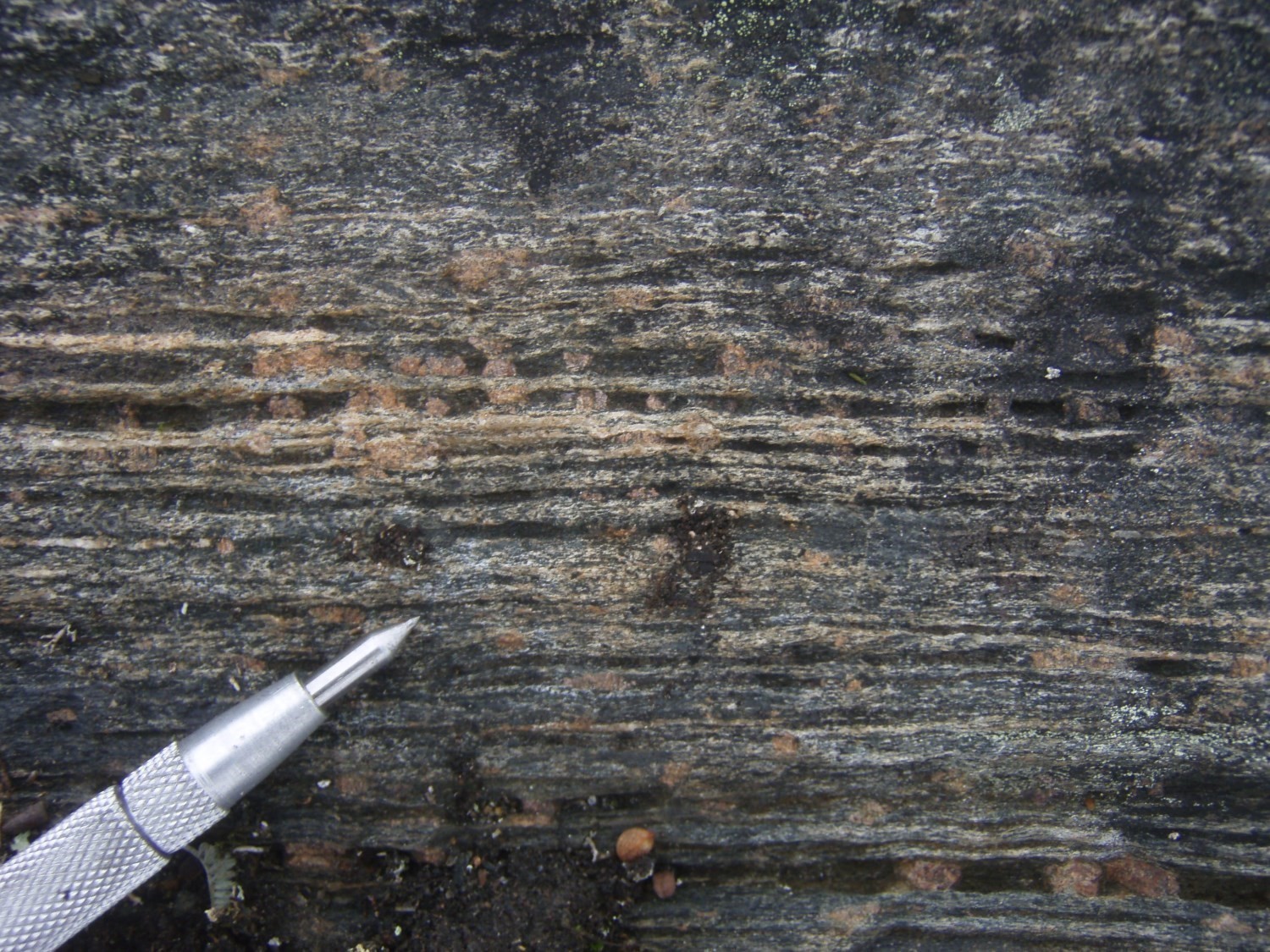
DISCLAIMER: This English version is translated from the original French. In case of any discrepancy, the French version shall prevail.
pPhe5 Plagioclase porphyritic (spotted) basalt
pPhe4 Mafic pyroclastics
pPhe3 Black slate, locally pyritic, and biotite schist
pPhe2 Massive basalt
pPhe1 Pillow basalt
| Author(s): | Sauvé and Bergeron, 1965 |
| Age: | Paleoproterozoic |
| Stratotype: | None |
| Type area: | Hellancourt Lake area (NTS sheet 24K04) |
| Geological province: | Churchill Province |
| Geological subdivision: | New Quebec Orogen (Labrador Trough) / Gerido and Payne lithotectonic zones |
| Lithology: | Basalt, gabbro, mudrock, pyroclastic rocks and amphibolite |
| Category: | Lithostratigraphic |
| Rank: | Formation |
| Status: | Formal |
| Use: | Active |
Background
The unit was originally described by Sauvé and Bergeron (1965) during geological mapping of the Gerido and Thévenet lakes area. These authors named the volcanic rocks that make up the formation after the Hellancourt Lake (NTS sheet 24K04) where the formation was studied in detail. It was then mapped by Bérard (1965) near the Trough’s western margin south of Bérard Lake (sheet 24L08), by Clark (1979, 1980) in the Koksoak River area south of latitude 58°N and in the Roberts Synclinal north of Kangirsuk in the far north of the Labrador Trough (Hardy, 1976; Bilodeau and Caron-Côté, 2018).
Description
Hellancourt Formation (pPhe): Massive or Pillow Basalt, Some Mafic and Sedimentary Pyroclastic Rocks, Mudrock and Amphibolite
The Hellancourt Formation is part of the Koksoak Group and comprises the majority of mafic volcanic rocks of the Labrador Trough’s second volcano-sedimentary cycle (Clark and Wares, 2004). Most rocks have the peculiarity of being similar from a compositional, petrographic and chemical perspective. They were initially defined as a sequence consisting of massive lava at the base and an abundance of pillow lava at the top (Sauvé and Bergeron, 1965).
In the Roberts Synclinal area, north of Kangirsuk (sheet 25D01), the unit subdivides from the base to the top into an undifferentiated sequence (pPhe) composed of basalt, characterized by the absence of a particular texture, and containing speckled (spotted) gabbro. These are interpreted as sills or coarse-grained flows. Spotted lavas are found mainly at the sequence’s base, but also at a few higher levels (Sauvé and Bergeron, 1965). The thickest gabbro passages are grouped into the pPhe5 unit. This unit is first overlain by pillow basalt (pPhe1), then massive basalt (pPhe2), some of which are intruded by gabbro Sills (pPhe5) and some of which contain thin horizons of black slate (pPhe3), some of which are sulphidic. Basalt with higher metamorphism was recrystallized to hornblende amphibolite (pPhe6). A mafic pyroclastics’ unit (pPhe4) was recognized in the north-central part of the Labrador Trough (Goulet, 1986), but has no identified equivalent in the Kangirsuk region. The only intrusive rocks observed are gabbro sills. No volcanic chimneys or feeding dykes were identified. The assumption is that feeding dykes are located outside the region. It is also possible that folds complicate interpretation (Sauvé and Bergeron, 1965).
Hellancourt basalt samples collected in 2017 show a signature of tholeiitic affinity. Immobile element ratios of Nb/Y and Zr/TiO2 allow characterization of the chemical evolution of magma over time (Winchester and Floyd, 1977). The results show Zr/TiO2 ratios with no significant variation, indicating a homogeneous basalt composition at the boundary of transitional basalts. Nb/Y ratios show a slightly more alkaline composition of the basal half (pPhe and pPhe5) than those of the summital half (pPhe1 and pPhe2). Rare earth profiles indicate a greater fractionation of the magma at the base of the sequence and a summit derived from a less evolved source or with less residence time in the crust.
Hellancourt Formation 1 (pPhe1): Pillow Basalt
The pillow basalt unit of the Hellancourt Formation (pPhe1) is composed of homogeneous, aphanitic rock forming decimetric to metric pillows. The rock is generally massive, but includes schistose zones attributed either to small horizons containing sediments, small deformation corridors, or to more carbonated, chloritized or altered basalt. The unit contains an unestimated percentage of gabbro, generally interpreted as metric to decametric intrusions, conformable and contemporaneous to other Hellancourt units (pPhe, pPhe2 and pPhe5). The unit also contains multiple decimetric, 3 m thick horizons of schistose black mudrock (pPhe3), sometimes graphic or sulphidic.
Pillows are joint and generally well individualized by chilled margins compossed of dark coloured and aphanitic material. Their structure is in the form of mattresses, buns or balls (Sauvé and Bergeron, 1965). Pillows are generally not vesicular (Sauvé and Bergeron, 1965), but the upper half of the unit contains tabular cavities (Clark, 1980). The top of the pillows contains elongated metric quartz and carbonate nodules interpreted as amygdules, which are common in the Roberts Synclinal area (sheets 25C04 and 25D01). There is little interpillow space filled with scoria, lava balls, quartz and carbonate (Sauvé and Bergeron, 1965). Polygonal joints are also observed locally. Also, centimetric to decimetric levels of brecciated or highly fractured material may correspond to hyaloclastite facies.
Typical samples of pillow basalt from the Roberts Synclinal area are homogeneous, massive and aphanitic to very fine-grained for the most part and fine to medium-grained for the others. The alteration patina is typically brownish and can be locally confused with that of an ultramafic rock. The fresh surface is usually light grey-greenish with rare shades of bluish grey or dark to blackish blue.
The unit has a microlithic texture, consisting of about 50% of a plagioclase, quartz, micas (chlorite and sericite), small acicular amphiboles and epidote matrix. The rock is composed of up to 50% small phenocrystals (< 5 mm) of acicular minerals interpreted, in most samples, as actinolite or tremolite. The rock often appears to be altered, as evidenced by pseudomorphs of plagioclase phenocrystals. Alteration and metamorphism parageneses are repeated from place to place. Chlorite, carbonates and metal minerals are minor constituents in most samples. Carbonates are found in both the matrix, veins and small phenocrystals. Secondary epidote usually appears as a late phase in small euhedral crystals in a few samples. Glass is sometimes still visible under the microscope (Sauvé and Bergeron, 1965).
Pillow basalts are locally cut by irregular and discontinuous thin veins, a few millimetres to a few centimetres-thick, cross-cutting stratification, or in extension cracks associated with deformation zones. These veins are composed of quartz, quartz-carbonate, quartz-carbonate-chlorite, carbonate only or chlorite only. They predate metamorphism and deformation as they are cut by amphiboles. They are particularly common on the edges and between pillows and zones containing mudrock interbeds. Carbonate and chlorite veins are common in sulphide zones.
The gabbro’s petrography and geochemistry are quite similar to those of the basalt. Gabbro is differentiated by its fine to medium grain size and its altered amphibole or plagioclase phenocrystal content, providing a characteristic speckled texture.
Hellancourt Formation 2 (pPhe2): Massive Basalt
The massive basalt unit (pPhe2) shares several compositional and structural characteristics with the pillow basalt unit (pPhe1) above it. Part of this unit may correspond to the massive, schistose basalt of the undifferentiated unit (pPhe), but does not contain speckled basalt (or very little), a facies interpreted either as gabbro sills or coarse-grained lava. Massive basalt contains low-carbonate, friable black shale horizons and rare medium-grained horizons, interpreted as a microgabbro. Some of these intrusions could be ultramafic. The relationship between basalt and gabbro is often ambiguous, as contact is unclear and difficult to distinguish. These correspond to zones that are particularly rich in carbonates, as evidenced by the presence of small calcite clusters. Geochemical similarity also complicates the mapping of flows and sills.
The unit is usually composed of massive, homogeneous rock, fine to very fine-grained, even aphanitic, rarely marked by a deformation fabric. It is characterized by very low structural and compositional variability. The colour of the rock is similar to that of pillow basalt, which is beige-greenish in altered surface and greenish grey in fresh exposure. Distinctive components are in the presence of coarse plagioclase and amphibole crystals dominated by actinolite and, to a lesser extent, tremolite and hornblende. These minerals are generally sericitized and chloritized. A second generation of chlorite crystallized in parallel lath clusters marks the main schistosity, accentuating the lepidoblastic texture in places. Titanite is a minor phase, but it is characteristic of the Hellancourt Formation as a whole. Other matrices and secondary minerals include epidote, quartz and up to 2% disseminated sulphides, including framboidal pyrite. The rock contains very little carbonate, but dissolved cavities are frequently observed in outcrop. Another feature of this unit is the presence of centimetric chlorite porphyroblasts distributed heterogeneously in the rock. The latter indicate that the rock has been metamorphosed to greenschist facies, or even upper greenschist facies for areas containing hornblende. Garnet was not observed in this unit.
The schistose horizons conformable with stratification’s origin has not been further developed. Schistosity is local, not penetrative, and does not appear to be associated with specific petrographic variations, lithological changes, or shear corridors. Instead, deformed zones have anastomosed schistosity, rock discolouration, fracturing, silicification, or an abundance of quartz or carbonate veins and black chlorite veinlets.
Hellancourt Formation 3 (pPhe3): Black Slate, Locally Pyritic, and Biotite Schist
Horizons of interstratified slate in the volcanic pile form sedimentary units of low extension and thickness ranging from <10 m to >30 m (Clark, 1980; Fournier, 1981; Wares and Goutier, 1989). The rock has thin, commonly wavy laminae. In places, current ripples and cross-bedding are observed (Clark, 1980). Slate is usually graphic and locally pyritic. It is black or dark grey in fresh exposure and rusty in altered surface due to pyrite oxidation, which is usually observed in thin laminas parallel to bedding and in cubic crystals (Clark, 1980; Fournier, 1981). Graphic black slate horizons are sedimentary or volcano-sedimentary (Clark, 1980).
In the Roberts Synclinal area, the unit consists of a few very fine-grained slate schist beds. This rock is black in fresh exposure and shows a completely altered and friable rust-coloured surface. Schist is composed of quartz (33-67%), biotite (20-54%), muscovite (0-12%), chlorite (0-16%), epidote (0-8%) and plagioclase (1-25%). Accessory minerals are hornblende, microcline, garnet, opaque minerals, calcite, apatite and tourmaline (Hardy, 1976).
Hellancourt Formation 4 (pPhe4): Mafic Pyroclastics
Mafic pyroclastics (pPhe4) interstratified in the basalt sequence are scarce in the Hellancourt Formation. They include mafic pyroclastic rocks, flow top breccias, pillow breccias and rarely mafic tuff and chert. Volcanic breccias form horizons ranging in thickness from 0.3 to 1 m (Fournier, 1981) and up to 5 m (Sauvé and Bergeron, 1965). These brecciated horizons are interbedded with pillow basalt flows or form the summit of pillow or massive flows (Clark, 1979, 1980; Fournier, 1981). They are composed of fragmented basaltic material with structures that resemble small pillows (Clark, 1980). The fragments, angular, subrounded or irregular in shape, have a diameter ranging from <1 cm to about 30 cm and a tight arrangement. The matrix is composed of carbonate, quartz and chlorite (Sauvé and Bergeron, 1965; Clark, 1979, 1980; Fournier, 1981). Basaltic tuff is present in horizons of a few metres thick (Clark, 1980).
A 3 m thick flow breccia of hyaloclastic material was observed by Goulet (1986) at Baie-aux-Feuilles (sheet 24K13). Goulet (1995) also reported the presence of channelized conglomerates interbedded between pillow basalt flows. Conglomerate beds are less than 3 m thick. They consist of vesicular lava, pyritic gabbro, mudrock and pyrite fragments. Pebbles are rounded to subrounded and rarely exceed 10 cm in diameter. The matrix, characterized by a very dark colour, is composed of reworked tuff (Goulet, 1995).
Hellancourt Formation 5 (pPhe5): Plagioclase Porphyritic (Spotted) Basalt
Unit pPhe5 groups outcrops where the speckled metagabbro and porphyritic basalt predominate over other basaltic units of the Hellancourt Formation. In the Roberts Synclinal area, this unit is predominantly present in the massive to schistose basalt at the volcanic sequence’s base (pPhe). The rock is characterized by homogeneity, fine to medium grain size, and a unique speckled (spotted) texture. It can be interpreted as microgabbro sills or coarse-grained lava, their composition and geochemical signature being similar to the fine-grained basalt hostrock. Contacts between gabbro and basalt are generally not marked, progressive or non-visible, which accentuates the similarities between these lithologies. Sill thickness is estimated to be a few tens of metres.
A variety of gabbro sills interpreted as late to post-volcanic intrusions are distinguished by sharp contacts and particularly schistose and altered basalt walls. However, their geochemical and structural affinities with the other gabbros favour their integration into the Hellancourt Formation. Other gabbros have a subophitic texture, a characteristic that is more representative of the Montagnais Sills (pPmon). However, field relationships and the nature of the contacts with the basalts support their belonging to the Hellancourt Formation.
The rock is generally mesococratic, with a brownish alteration patina that can be confused with that of basalt. It is greenish-grey to dark greenish brown in fresh exposure, giving it a locally melanocratic appearance. The main components are acicular amphiboles and plagioclase. The unit is distinguished from other Hellancourt facies by the presence of damouritized plagioclase or chloritized amphibole phenocrystals, the best criterion for their identification in the field. Few samples appear to contain some hornblende. Secondary components are chlorite, epidote, carbonate and titanite, the lalter being ubiquitous in all the facies of the Hellancourt Formation. Epidote can make up 20% of the rock, especially in small euhedral crystals of metamorphic origin, but also in veinlets or associated with altered plagioclase. Sulphides account for up to 2-3% of the rock and are concentrated in microfractures.
Rocks are commonly cut by veinlets, veins or clusters up to 5 cm wide and composed of soft blackish material interpreted as chlorite. The latter is also a constituent of quartz veins that abound in the schistosity plane, as well as carbonate, as evidenced by the dissolved cavities in the veins and surrounding rock.
Hellancourt Formation 6 (pPhe6): Amphibolized Basalt
Amphibolite of the Hellancourt Formation (pPhe6) is interpreted as a higher metamorphic grade equivalent of the other Hellancourt units. The complete loss of primary structures associated with metamorphism does not make it possible to know with certainty which of the original units the rock belongs. In the field, rocks of the pPhe6 unit may be confused with some dark-coloured metasediments. Amphibolite is generally grey to dark green to blackish.
The rock is fine to very fine-grained, granoblastic, equigranular and generally mesocratic and banded. Amphibolite is composed on average of 60% amphibole and 40% plagioclase. Amphibole bands are largely dominated by stocky recrystallized hornblende, with rare actinolite. Non-twinned plagioclase crystals combine with quartz to form alternating leucocratic bands.
South of the Arnaud River (sheets 24N12 and N13), amphibolite is composed of approximately 5% coronitic garnet, resulting from a higher metamorphic pressure than that which affected rocks of the Roberts Synclinal. Garnet is medium-grained, poikilitic with quartz or plagioclase inclusions, homogeneously distributed and surrounded by quartz.
Thickness and Distribution
The Hellancourt Formation is part of the Labrador Trough’s second volcano-sedimentary cycle. It outcrops in the north-central (southwest of Kuujjuaq) to the far north of the Trough (north of Kangirsuk). In the Kuujjuaq region, unit thickness was estimated to be between 1000 and 1500 m on a regional fold’s western flank, reduced in thickness on the eastern flank due to a shear zone (Sauvé and Bergeron, 1965). In the Kangirsuk region, the Hellancourt Formation is the thickest of Paleoproterozoic units. In the Roberts Synclinal, the unit’s thickness also varies significantly due to the presence of numerous local folds and imbrication of the sequence along thrust fronts east of the synclinal. Its thickness is roughly estimated at a minimum of 1500 m on the east side and up to 8000 m on the west side.
Dating
None.
Stratigraphic Relationship(s)
A glomerophyric gabbro dyke intruding the Hellancourt Formation’s summital strata was analyzed to constrain the age of the end of volcanism in the Baie-aux-Feuilles region (Machado et al., 1997). The average results show an age of 1874 ±3 Ma that was correlated with an age of 1870 ±4 Ma obtained for a rhyodacite in the Douay Formation (Machado et al., 1997). The authors conclude that the Hellancourt Formation’s age is 10 to 14 Ma younger than that of the Sokoman Formation‘s iron formations.
The Hellancourt Formation overlies turbidites of the Menihek Formation with interlocking contact over a transition zone of at least 1 km. Cartographic contact between the two units occurs when the proportion of basalt at the top of the Menihek Formation exceeds 50% in outcrop. The unit stratigraphically overlying the Hellancourt Formation is completely eroded in the Roberts Synclinal area.
The normal polarity of the Hellancourt units is reflected in a basal undifferenciated sequence (pPhe) cut by abundant speckled gabbro sills (pPhe5), some of which are possibly progressive contact coarse-grained lava, overlain by massive flows (pPhe2), and then pillow flows (pPhe1) at the top. Some of the summital units are intruded with gabbro (pPhe5) and others contain thin horizons of black slate (pPhe3) and sulphide clusters. All contacts are sharp and interlocking. There are a few exceptions where massive flows change laterally to pillow lava (Sauvé and Bergeron, 1965). Gabbro sills (or coarse-grained flows) of the pPhe5 unit were observed alternating with mudrocks and quartz arenites of the Menihek Formation (pPme), underlying the Hellancourt Formation. The Hellancourt Formation’s base can be followed continuously in contact with the Baby Formation’s ferriferous upper member in the Kuujjuaq region, without the presence of the Menihek Formation (Sauvé and Bergeron, 1965). Finally, there does not appear to be any apparent relationship between the Hellancourt Formation and other mafic units in the region, be it the Montagnais Sills or the Baie Kyak Intrusion.
Paleontology
Does not apply.
References
Publications available through SIGÉOM Examine
BILODEAU, C., CARON-COTE, E., 2018. Géologie de la région de la rivière Arnaud, provinces du Supérieur (Minto) et de Churchill (Fosse du Labrador), secteur de Kangirsuk, Nunavik, Québec, Canada. MERN; BG 2018-04, 2 plans.
CLARK, T., 1979. REGION DU LAC NAPIER (NOUVEAU-QUEBEC) – RAPPORT PRELIMINAIRE. MRN; DPV 663, 28 pages, 1 plan.
CLARK, T., 1980. REGION DE LA RIVIERE KOKSOAK (NOUVEAU-QUEBEC) – RAPPORT PRELIMINAIRE. MRN; DPV 781, 24 pages, 1 plan.
CLARK, T., WARES, R., 2004. SYNTHESE LITHOTECTONIQUE ET METALLOGENIQUE DE L’OROGENE DU NOUVEAU-QUEBEC (FOSSE DU LABRADOR). MRNFP; MM 2004-01, 182 pages, 1 plan.
CLARK, T., WARES, R., 2006. LITHOTECTONIC AND METALLOGENIC SYNTHESIS OF THE NEW QUEBEC OROGEN (LABRADOR TROUGH). MRNF; MM 2005-01, 178 pages, 1 plan.
FOURNIER, D., 1981. GITES DE Cu-Zn ET Cu-Ni DANS LA PARTIE NORD DE LA FOSSE DU LABRADOR. MRN; DPV 835, 28 pages, 3 plans.
GOULET, N., 1986. ETUDE TECTONIQUE ET STRATIGRAPHIQUE DE LA PARTIE NORD DE LA FOSSE DU LABRADOR – REGION DE LA BAIE AUX FEUILLES ET DU LAC BERARD. MRN; MB 86-27, 22 pages, 6 plans.
GOULET, N., 1987. ETUDE TECTONIQUE DE LA PARTIE NORD DE LA FOSSE DU LABRADOR RAPPORT PRELIMINAIRE. MRN; MB 87-21, 33 pages, 4 plans.
GOULET, N., 1995. ETUDE STRUCTURALE, STRATIGRAPHIQUE ET GEOCHRONOLOGIQUE DE LA PARTIE NORD DE LA FOSSE DU LABRADOR. MRN; MB 95-36, 41 pages, 1 plan.
KISH, L., TREMBLAY-CLARK, P., 1978. GEOCHIMIE ET RADIOACTIVITE DANS LA FOSSE DU LABRADOR. MRN; DPV 567, 73 pages.
SAUVE, P., BERGERON, R., 1965. REGION DES LACS GERIDO ET THEVENET, NOUVEAU-QUEBEC. MRN; RG 104, 141 pages, 3 plans.
WARES, R., BERGER, J., 1987. SYNTHESE METALLOGENIQUE DES INDICES DE SULFURES AU NORD DU 57e PARALLELE – FOSSE DU LABRADOR. I R E M; MB 87-19, 15 pages, 1 plan.
WARES, R., BERGER, J., ST-SEYMOUR, K., 1988. SYNTHESE METALLOGENIQUE DES INDICES DE SULFURES AU NORD DU 57e PARALLELE (ETAPE 1) – FOSSE DU LABRADOR -. I R E M; MB 88-05, 202 pages, 1 plan.
WARES, R., GOUTIER, J., 1989. METALLOGENIE DES INDICES DE SULFURES AU NORD DU 57e PARALLELE (ETAPE II) – FOSSE DU LABRADOR -. MRN; MB 89-38, 122 pages, 1 plan.
WARES, R., GOUTIER, J., 1990. SYNTHESE METALLOGENIQUE DES INDICES DE SULFURES AU NORD DU 57e PARALLELE – FOSSE DU LABRADOR – RAPPORT INTERIMAIRE – ETAPE III. IREM-MERI; MB 90-25, 104 pages, 2 plans.
Other publications
MACHADO, N., CLARK, T., DAVID, J., GOULET, N., 1997. U-Pb ages for magmatism and deformation in the New Quebec Orogen. Canadian Journal of Earth Sciences; volume 34, pages 716-723. https://doi.org/10.1139/e17-058
Suggested Citation
Ministère de l’Énergie et des Ressources naturelles (MERN). Hellancourt Formation. Quebec Stratigraphic Lexicon. https://gq.mines.gouv.qc.ca/lexique-stratigraphique/province-de-churchill/formation-hellancourt_en [accessed on Day Month Year].
Contributors
|
First publication |
Carl Bilodeau, géo., M. Sc. carl.bilodeau@mern.gouv.qc.ca; Emmanuel Caron-Côté, géo. stag., M. Sc. emmanuel.caron-cote@mern.gouv.qc.ca (rédaction) Mehdi A. Guemache, P. Geo., Ph.D. (coordination); Simon Auclair, P. Geo., M.Sc. (critical review and editing); Céline Dupuis, P. Geo., Ph.D. (English version); Marie-Ève Lagacé and Ricardo Escobar Moran (HTML editing). |







